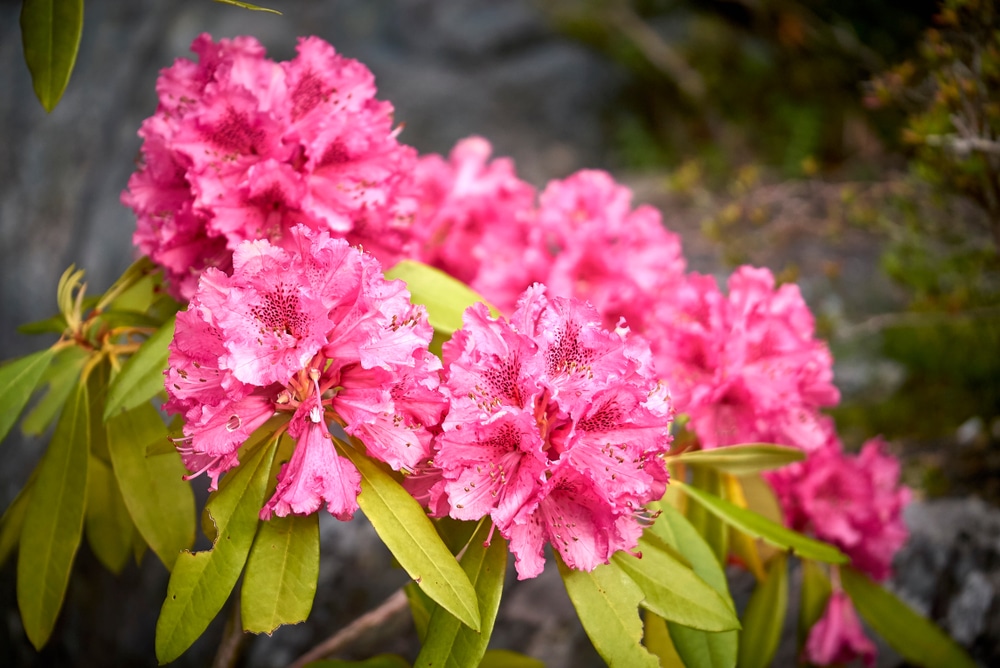The Girard Crimson Azalea is a stunning varietal that produces an abundance of flowers. These flowers are set against a backdrop of lush, green foliage, making for a dramatic display.
It has deep crimson petals that are accented by a small yellow center, and the blooms are produced in profusion from late spring to early summer. Its attractive foliage, with glossy dark green leaves that turn a brilliant red in the fall.
While it does best in moist, well-drained soil, it can also tolerate periods of drought. With its exquisite blooms and long season of interest, the Girard Crimson Azalea is an irresistible addition to any landscape.

| Botanical Name | Azalea X ‘Girard’s Crimson’ |
| Common Name | Girard Crimson Azalea |
| Plant Type | Perennial |
| Flower Color | Crimson red about 2 inches wide |
| Size When Mature | 24-48 inches |
| Bloom Time | Spring |
| Sun Requirements | Partial to Full Sun |
| USDA Hardiness Zones | 5 – 8 |
| Soil PH Range | 5.0 – 5.5 |
| Soil Type | Acidic, moist, but well-draining |
| Water Needs | Medium |
| Native Area |
North America |
What You Need to Know About Girard Crimson Azalea
A deciduous shrub native to North America, this plant can grow quite large, reaching 24-48 inches in height. The plant’s leaves are elliptical in shape and have a smooth, shiny texture. Additionally, they are arranged in pairs along the stems, and each leaf measures approximately 4 inches long.
This plant gets its crimson name from its vibrant flowers, which bloom in shades of deep red. They typically bloom in spring, and they last for several weeks. Each flower measures approximately 2 inches wide, and they are borne in clusters of 3-5.
The Girard Crimson Azalea is a plant that is easy to grow and care for. It is relatively drought-tolerant and can thrive in a variety of soil types. Any new gardener will be able to successfully grow this plant with ease.
How to Care for Girard Crimson Azalea
Here’s everything you need to know about growing and caring for a thriving Girard Crimson Azalea:
Light
When it comes to light, the Girard Crimson Azalea does best in partial shade to full sun. Giving the plant at least 5 hours of sunlight each day is ideal. Additionally, the plant will tolerate some shade, especially during the heat of the day.
Water and Soil Needs
Girard Crimson Azalea likes to be watered often, especially when the plant is young. Once it’s established, it can be allowed to dry out a bit between watering. However, during extended periods of drought, increasing your watering frequency is necessary to prevent the plant from stress.
In terms of soil, the plant is not picky. It will do well in various soil types but does best in rich and well-draining soil with a pH range of 5.0-5.5. Ensuring the soil is rich in organic matter will also help the plant to thrive. If your soil is not acidic enough, you can amend it with sulfur to lower the pH.
Temperature Requirements
Being in a cooler climate is ideal for the Girard Crimson Azalea. It is hardy in USDA zones 5-8 and can tolerate temperatures as low as -5 °F. However, even if the plant is cold hardy, it’s best to provide some winter protection, such as mulch, to prevent the roots from being damaged by the cold. Additionally, the plant blooms better in cooler weather, so if you live in a warmer climate, you may not get as many flowers.
Fertilizer
The best fertilizer to use on a Girard Crimson Azalea is a balanced and slow-releasing fertilizer. This type of fertilizer will provide the nutrients the plant needs without burning the roots. It is also best to fertilize in early spring, just as the plant is starting to bloom.
Common Diseases
The Girard Crimson Azalea is relatively disease-resistant. However, there are a few diseases that can cause problems for the plant. These include canker, crown rot, and root rot to name a few.
Canker is a disease that affects the stems and branches of the plant. It appears as sunken, dark areas on the bark. It is a fungal disease that attacks the plant through wounds in the bark. Because of this, the plant can quickly die if it is not treated immediately.
Another disease is crown rot, which is caused by a fungus. It attacks the plant through the roots and can quickly kill the plant if it is not treated. The best way to prevent crown rot is to make sure the plant has well-draining soil and is not being overwatered.
Finally, root rot is a fungal disease that can be deadly to the plant. It is caused by overwatering and results in the roots of the plant rotting. The plant will start to wilt and turn yellow, and eventually, it will die.
Watch out for these diseases, and if you notice any symptoms, be sure to treat the plant immediately.
Girard Crimson Azalea Propagation
Getting this plant to multiply is relatively easy. The best way to propagate the Girard Crimson Azalea is through stem cuttings. To do this, take a 6-inch cutting from a healthy part of the plant. Choose a mature stem that has new growth. Cut the stem just below a leaf node, and remove the lower leaves.
You may optionally dip this to a rooting hormone. While it isn’t necessary, this increases your chances of getting your cuttings to root.
Next, plant the cutting in a pot of well-draining soil. Water the soil, and then place the pot in a warm area with indirect light. Be sure to keep the soil moist but not wet. The cutting should root within 4-6 weeks.
To propagate through seeds, you will need to wait until the flowers have faded and the seed pods have formed. Once they are dry, open up the pods and remove the seeds. After retrieving the seeds, plant them in moistened soil. The seeds should germinate within 4-6 weeks. Once they have sprouted, you can then transplant them into a pot or the ground.
